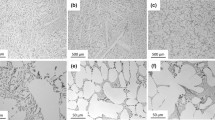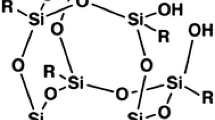Abstract
A strontium-modified experimental Al20Si3Cu alloy was processed using the squeeze casting/high pressure die casting universal metallurgical simulator and analyzer (SC/HPDC UMSA) under impact and cyclic loading. Sample pressure and temperature vs. time were monitored during solidification, allowing thermal analysis to identify key solidification parameters. The application of pressure to the melt region improves the contact between the melt and the steel mold, which increases the initial melt cooling rate to ~100 °C/s and heat extraction by 40%. Metallographic analysis techniques including LOM, SEM/EDS, STEM/EDS were used to characterize the as-cast microstructure and microchemistry of selected samples. Metallographic data were collected from the polished and deep-etched surfaces as well as from STEM thin foils. This data allowed for the gathering of complementary information for determination of the relationship between the process and the thermal analysis parameters. The best processing parameters produced as-cast composite colonies that had a high fraction (~38 vol. %) dispersion of nanosized, individual, amorphous, Si-rich SiAl clusters and whiskers in a face-centered cubic (FCC) α-Al matrix. The clusters and whiskers had an average diameter of 220 nm with a standard deviation of 48 nm and whiskers were ~2 µm long. This nanocomposite structure was in the form of ~500 µm cauliflower-florets-shaped colonies of radial cells of ~30 µm in diameter that accounted for >85% of the material volume. We describe the process of formation of these newly discovered glassy SiAl nanophase clusters and whiskers in an FCC α-Al matrix. This ultrafine phase is a main, dominant feature of the as-cast ultrafine microstructure of Sr-modified, hypereutectic Al20Si3CuX alloy solidified under non-equilibrium conditions controlled by rapid heat extraction.


















Similar content being viewed by others
Availability of Data and Material
All data are published in the PhD dissertation.5 Experimental materials were donated by Yamaha Motors Company, Japan. Software applications such as SC/HPDC UMSA were developed by Dr. Al Conle and Dr. Marcin Kasprzak, while concept and hardware design by Dr. Jerry Sokolowski.
Code Availability
UMSA SC/HPDC Control/Monitoring Software and HT UMSA Thermal Analysis Software (both proprietary software), commercial Octave routines, and open source fatigue test control software consisting of C++, FORTRAN, Linux Bash scripts, and commercial Microstar DAP platform software and hardware.
References
W. Kasprzak, H. Kurita, J.H. Sokolowski, H. Yamagata, Energy-efficient tempers for aluminum motorcycle cylinder blocks. Adv. Mater. Process. 168(3), 24–27 (2010)
“New honing options for hypereutectic Aluminum cylinder Bores-honing-options-for-hypereutectic-aluminum-cylinder-bores,” 2013. https://www.mmsonline.com/articles/new-honing-options-for-hypereutectic-aluminum-cylinder-bores
W. Kasprzak, M. Sahoo, J.H. Sokolowski, H. Yamagata, H. Kurita, The effect of the melt temperature and the cooling rate on the microstructure of the Al-20% Si alloy used for monolithic engine blocks. Int. J. Met. 3, 55–71 (2009). https://doi.org/10.1007/BF03355453
H. Yamagata, W. Kasprzak, M. Aniolek, H. Kurita, J.H. Sokolowski, The effect of average cooling rates on the microstructure of the Al-20% Si high pressure die casting alloy used for monolithic cylinder blocks. J. Mater. Process. Technol. 203(1–3), 333–341 (2008). https://doi.org/10.1016/j.jmatprotec.2007.10.023
P. Guba, Development of Novel Nano – Single Si Phase Cast Hypereutectic Al-Si Alloys (Doctoral Thesis, University of Windsor, ON, Canada, 2015). https://scholar.uwindsor.ca/etd/5694
P. Guba, A.J. Gesing, J.H. Sokolowski, A. Conle, A. Sobiesiak, S.K. Das, In situ - formed, low - cost, Al - Si nanocomposite materials. Arch. Mater. Sci. Eng. 84(1), 5–22 (2017). https://doi.org/10.5604/01.3001.0010.7564
P. Guba, A. Gesing, J. Sokolowski, A. Conle, A. Sobiesiak, M. Kasprzak, Combined thermal, microstructural and microchemical analysis of solidification of Al25Si3Cu Alloy. Arch. Mater. Sci. Eng. 85(2), 49–79 (2017). https://doi.org/10.5604/01.3001.0010.3428
P. Guba et al., In-situ formed, ultrafine Al-Si composite materials: ductility. J. Achiev. Mater. Manuf. Eng. 92(1–2), 5–12 (2019). https://doi.org/10.5604/01.3001.0013.3182
M. Calvo-Dahlborg, P.S. Popel, M.J. Kramer, M. Besser, J.R. Morris, U. Dahlborg, Superheat-dependent microstructure of molten Al-Si alloys of different compositions studied by small angle neutron scattering. J. Alloys Compd. 550, 9–22 (2013). https://doi.org/10.1016/j.jallcom.2012.09.086
P. Popel, U. Dahlborg, M. Calvo-Dahlborg, On the existence of metastable microheterogeneities in metallic melts. IOP Conf. Ser. Mater. Sci. Eng. 192(1), 012012 (2017). https://doi.org/10.1088/1757-899X/192/1/012012
W. Wang, X. Bian, J. Qin, S.I. Syliusarenko, The atomic-structure changes in AI-16 Pct Si alloy above the liquidus. Metall. Mater. Trans. A Phys. Metall. Mater. Sci. 31(9), 2163–2168 (2000). https://doi.org/10.1007/s11661-000-0134-y
J. Barrirero, M. Engstler, N. Ghafoor, N. De Jonge, M. Odén, F. Mücklich, Comparison of segregations formed in unmodified and Sr-modified Al – Si alloys studied by atom probe tomography and transmission electron microscopy. J. Alloys Compd. 611, 410–421 (2014). https://doi.org/10.1016/j.jallcom.2014.05.121
J. Barrirero, Eutectic modification of Al-Si casting alloys. Linköping University (2019). https://doi.org/10.3384/diss.diva-160235
J. Barrirero et al., Eutectic modification by ternary compound cluster formation in Al-Si alloys. Sci. Rep. 9(1), 1–10 (2019)
Funding
This research was supported by AUTO 21 and the University of Windsor. This research concept was developed and executed at the University of Windsor and the Silesian University of Technology facilities under regular conditions.
Author information
Authors and Affiliations
Contributions
PG, JS and AS were involved in conceptualization. PG, JS, AG, AC, AS and MK were involved in methodologies. PG and AC were involved in experimental execution. PG, JS, AG, AC and MK were involved in formal analysis and investigation. PG, JS, AG and AS were involved in writing—original draft preparation. PG, JS, AG and AS were involved in writing review and editing. AUTO 21, University of Windsor was involved in funding acquisition. JS and AS were involved in supervision.
Corresponding author
Ethics declarations
Conflict of interest
The authors have no conflict of interest to declare regarding the content of this article.
Ethical Approval
Not applicable
Consent to Participate
The participants have consented to the submission of the case report to the Journal.
Consent for Publication
The participants have consented to the publication of the case report to the International Journal of Metalcasting (IJMC).
Additional information
Publisher's Note
Springer Nature remains neutral with regard to jurisdictional claims in published maps and institutional affiliations.
Rights and permissions
Springer Nature or its licensor holds exclusive rights to this article under a publishing agreement with the author(s) or other rightsholder(s); author self-archiving of the accepted manuscript version of this article is solely governed by the terms of such publishing agreement and applicable law.
About this article
Cite this article
Guba, P., Sokolowski, J., Gesing, A. et al. Development of Cast Hypereutectic Al-Si-X Alloys with Ultrafine–Si Phase Part 1: As-cast Structure Development. Inter Metalcast 17, 1535–1557 (2023). https://doi.org/10.1007/s40962-022-00888-5
Received:
Accepted:
Published:
Issue Date:
DOI: https://doi.org/10.1007/s40962-022-00888-5




